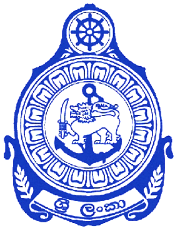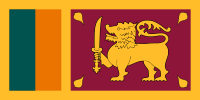| Sri Lanka Navy |
|---|
 |
| Components |
| History |
| Ships |
| Leadership and ranks |
The Sri Lanka Navy (SLN) (Sinhala: ශ්රී ලංකා නාවික හමුදාව, romanized: Śrī Laṃkā nāvika hamudāva; Tamil: இலங்கை கடற்படை, romanized: Ilaṅkai kaṭaṟpaṭai) is the naval arm of the Sri Lanka Armed Forces and is classed as the country's most vital defence force due to its island geography. It is responsible for the maritime defence of the Sri Lankan nation and its interests. The role of the Sri Lanka Navy is to conduct operations at sea for the defence of the nation and its interests and conduct prompt and sustainable combat operations at sea in accordance with the national policies.[3]
Sri Lanka, situated in the middle of major sea lanes passing through the Indian Ocean, was always a magnet for seafarers and has a long history of naval campaigns. The current Sri Lankan Navy was established on 9 December 1950 when the Navy Act was passed for the formation of the Royal Ceylon Navy. The roots of the modern Sri Lankan Navy date back to 1937 when the Ceylon Naval Volunteer Force was established, which was renamed and absorbed into the Royal Navy as the Ceylon Royal Naval Volunteer Reserve during World War II. The current name, Sri Lanka Navy, was constituted in 1972 when Sri Lanka became a republic and with the introduction of new constitution.
It played a key role in the Sri Lankan Civil War, conducting surveillance and patrol, amphibious and supply operations. During the war, the navy moved from a small force focused on coastal patrols to a large combat force concentrating on asymmetric naval warfare capable of amphibious and land operations in support of counter-insurgency operations that progressed into engagements of a new form of littoral zone warfare. It carried out expeditionary deployments in the Indian Ocean in order to intercept rogue arm shipments on the high seas. The navy has its own elite special forces unit, the Special Boat Squadron.
The professional head of the navy is the Commander of the Navy, currently Vice Admiral Priyantha Perera.[4] The commander-in-chief of the Sri Lanka Armed Forces is the President of Sri Lanka, who heads the National Security Council; the Ministry of Defence is the organization where ship buying policies are made for the navy.[5] The Sri Lanka Navy has five Advanced Offshore Patrol Vessels (equivalent to a traditional patrol frigate), three Offshore Patrol Vessels, two missile boats, 40 fast attack crafts, more than 200 patrol boats, seven landing ships/craft, along with six auxiliary vessels.[6]
- ^ "Sri Lanka's plan to downsize military Tri-forces halt general recruitment". dailymirror.k. Archived from the original on 26 September 2024. Retrieved 11 March 2024.
- ^ Mallawarachi, Bharatha (9 January 2024). "Sri Lanka to join US-led naval operations against Houthi rebels in Red Sea". ABC News. Archived from the original on 10 January 2024. Retrieved 10 January 2024.
- ^ "About Us". Sri Lanka Navy. Archived from the original on 2007-10-26. Retrieved 2007-10-07.
- ^ "2014/06/29/sec02". sundayobserver.lk. Archived from the original on 2016-10-04. Retrieved 2018-08-16.
- ^ "Commander-in-Chief Completes One Year in Office". Media Centre for National Security. 2007-03-08. Archived from the original on 2007-09-28. Retrieved 2007-04-20.
- ^ "Sri Lanka Navy". www.navy.lk. Archived from the original on 2024-09-26. Retrieved 2021-09-29.

